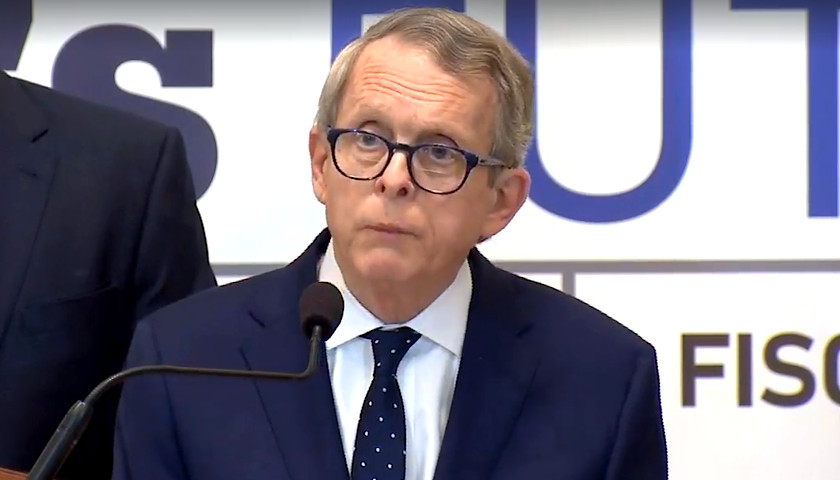Gov. Mike DeWine (R-OH) released his first two-year budget proposal Friday morning in what he is describing as a $69 billion investment in “Ohio’s future.”
“As I shared in my State of the State address, the Bible tells us that there is a time and a place for everything. Now is the time for us to invest in Ohio,” DeWine said in a letter addressed to his “fellow Ohioans.”
“We must invest in our children to help our youngest Ohioans get the best start in life. We must invest in efforts to fight mental health and substance use disorders so our fellow Ohioans can lead fulfilling, healthy lives. We must invest in Ohio’s workers and in innovation and technology that spurs job creation so our families can prosper. And, we must invest in preserving and protecting Lake Erie and all of Ohio’s waterways, so that all Ohioans have access to clean water and our outdoor spaces are preserved for generations to come,” he continued, touching on the main priorities of his budget.
While the proposal places a significant emphasis on mental health and child support services, DeWine identified five core areas for his budget, including:
- Children and Families
- Local Communities
- Natural Wonders
- RecoveryOhio
- Workforce and Innovation
Ohio Democrats praised DeWine for his plans to invest more in early childhood programs, such as his commitment to making Ohio’s homes lead free. His proposal includes an investment of $46.5 million in early intervention programs to provide children with toxic lead exposure or neonatal abstinence syndrome “with the services and supports they need to grow into strong adults.”
He’s asking for another $22 million in funds for programs that would tackle lead exposure in Ohio’s homes.
“It is wrong that in 2019 there are still children whose opportunities and whose dreams are stifled because they live in homes where they are exposed to lead paint,” DeWine states in his proposal.
The funding would be broken down into annual investments of “$5.8 million to advertise lead-free homes to families, abate and remediate lead contamination, and demolish lead-blighted homes; $225,000 to increase the supply of lead hazard control workers, which has historically impeded lead abatement in Ohio; and $5 million to create a lead abatement tax credit, allowing eligible individuals to receive an income tax credit worth up to $10,000 for costs related to home lead abatement.”
DeWine is also calling for $140 in additional funding for children services agencies, which would nearly double the current budget for those programs. Other proposals, however, are a bit more unexpected, such as his request for $5 million for an “Ohio Books from Birth Foundation” so the state can “provide all Ohio children with a monthly book for the first five years of their life.”
Here’s a look at some other surprising elements of DeWine’s proposal:
$60 million to improve indigent defense system
DeWine wants an increase in $60 million per year to assist in “providing counsel for defendants who cannot afford an attorney.”
“This unprecedented support for indigent defense demonstrates Governor DeWine’s belief that the state must help local partners provide individuals with their Constitutional right to counsel,” the proposal suggests.
Currently, state reimbursements to counties for indigent defense is capped at 50 percent, but DeWine wants to eliminate that cap and help “alleviate local budget pressures by making county general funds available for other purposes.”
$900 million ‘H2Ohio’ Fund
DeWine is seeking to create a new “H2Ohio” fund that would “ensure safe and clean water across Ohio by providing the resources necessary to plan, develop, and implement targeted, long-term water solutions.”
The fund could reach up to $900 million over a 10-year period and would collect money from whatever surplus remains at the end of each biennium.
“Water is vital, yet communities throughout the state regularly face challenges such as algae blooms, failing septic tanks, nutrient pollution, and threats of lead contamination,” the proposal states.
$5 million annually for electric car charging stations
The Republican governor’s budget proposal contains a significant number of environmental investments, including a recommendation of $5 million annually for “electric vehicle charging infrastructure,” and another $1 million for environmental education programs.
Additionally, DeWine would like to see an investment of $43 million to make “state park improvements” to “expand capacity, upgrade utilities and safety measures, and to renovate cabins, lodges, campgrounds, and trails.” He also wants another $4.5 million to help fight “harmful invasive species.”
Under his proposal, the Ohio Environmental Protection Agency would receive an additional $31 million annually to reduce “air pollution” by replacing “aging diesel school and transit buses, heavy duty trucks, and cargo handling equipment, and to repower diesel engines in tug boats and locomotives.”
$15 million each year for free workforce credentials
In the workforce and innovation section of his proposal, DeWine calls for $15 million in annual funding to provide “recognized industry credentials” at “no cost” to a minimum of 10,000 Ohioans per year.
“Micro-degrees are low-cost credentials that take a student less than a year to complete and quickly qualify Ohioans to work in growing industries,” the proposal explains.
DeWine would also like to see a $47 million increase over two years in funding for the Ohio College Opportunity Grant, and an additional $6 million for qualifying students to “purchase textbooks and instructional materials.”
DeWine’s full budget proposal can be read here. Check back at The Ohio Star for more updates on his budget.
– – –
Anthony Gockowski is managing editor of Battleground State News and The Minnesota Sun. Follow Anthony on Twitter. Email tips to [email protected].
Photo “Mike DeWine” by Mike DeWine.





